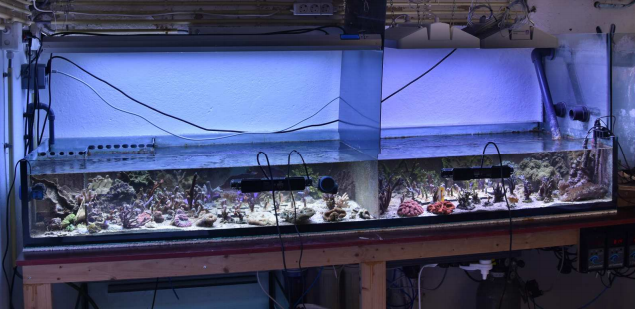The team at Philips didn’t just slap some diodes into a box and call it a LED light for coral as it is showing it has put serious consideration into this product. In fact, Philips commissioned Tim Wijgerde, Ph.D. of Coral Publications to run a preliminary test of the CoralCare vs. T5 lamps to test the hypothesis, “What is the performance of the CoralCare LED unit, in terms of stimulating coral growth, shape and coloration, compared to conventional T5 technology?”
The test ran over the course of a month, using two CoralCare lights over one section of a tank divided by PVC pitted up against a pair of ATI Sunpower, 6x54W dimmable T5 fixtures with a total of 12 Aquablue Spezial 12,000 Kelvin bulbs. Although these are perceived as rather warm by reefing standards (even noted in the report), this gives a spectrum to compare growth.
For corals, there were a variety of SPS corals including Stylophora pistillata, a purple morph of Acropora sp., and a green morph of Acropora cf. muricata. After one month of balancing lighting, flow and parameters, the study found there was little difference in the growth rate, coloration and shape of the coral, however there was a 30% higher wall–plug efficiency gained from going LED.
Of course, this was just a test ran for a month and we’d have to see longer-term tests in order to draw other conclusions around growth, color and morphology. Many reefers and vendors tout better growth and coloration from LEDs and while these are mainly subjective, it is nice to see a scientific test completed. We are looking forward to hearing more from Philips over the next few months.
Here is the overall report summary, but you can see the entire report here:
“This report presents the preliminary results obtained during a field test of the CoralCare LED unit developed by Philips. The goal of the field test was to evaluate the performance of the CoralCare unit as a light source for marine aquaria, in particular corals.
Two 190W CoralCare units were placed above a 490L aquarium (dimensions 200 x 70 x 35 cm), as well as two T5 reference luminaires (ATI Sunpower, 6x54W dimmable each). The aquarium was divided into two sections using a PVC separator, to prevent cross-over effects of each light source. Quantum irradiance (photosynthetically active radiation, ~400–700 nm) was set to ~560 µmol photons m-2 s-1. Water flow was created by placing one flow pump (Maxspect Gyre 150) in each section, operating at 20% power at constant forward flow, resulting in a water flow rate of 10–15 cm s-1 around the corals.
In each section, three scleractinian coral species (N=5 fragments per species for each light source) were cultured; a pink morph of Stylophora pistillata, a purple morph of Acropora sp., and a green morph of Acropora cf. muricata (Ntotal=30 fragments). The performance of both light sources was evaluated by measuring the specific growth rate of each coral species, as well as by subjective photographic analysis of their morphology and colour.
After one month of culture, growth rates obtained under the T5 and CoralCare LED units were 2.7±0.3% and 2.8±0.4% day-1 for Stylophora pistillata, respectively. For the purple Acropora sp., growth rates were 1.7±0.4% under T5 and 1.7±0.3% day-1 under CoralCare LED. Acropora cf. muricata exhibited growth rates of 2.5±0.3% and 2.2±0.3% under T5 and CoralCare LED, respectively.
No significant growth differences between T5 and CoralCare LED were found, for any species, although growth differences between species were detected, irrespective of light source. Subjective evaluation of photographs suggests that coral morphology and colouration are similar between light sources after one month of culture. In preliminary conclusion, the newly CoralCare unit developed by Philips delivers results which seem equal to conventional T5 technology, at 30% higher wall–plug efficiency. This report will be followed up by a more detailed analysis of coral growth, morphology and colouration after several months of culture.”
[Images via Philips, Thanks to Toby for pointing us to the report]



